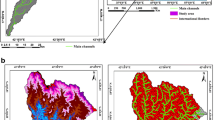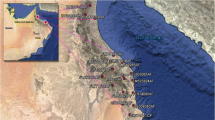Abstract
Rainfall distribution patterns (RDPs) are crucial for hydrologic design. Hydrologic modeling is based on Soil Conservation Services (SCS) type RDPs (SCS type I, IA, II, and III). SCS type II method is widely used by hydrologists in arid regions. These RDPs were designed for the USA and similar temperate regions. There is no scientific justification for using SCS type II method in arid regions. The consequences of using SCS type II have impacts on the hydrologic and hydraulic modeling studies. The current paper investigates the validity of the SCS type II and in arid regions. New temporal RDPs were applied and compared with SCS type II RDPs. The produced peak discharges, volumes, maximum inundation depths, top widths, and velocities from both approaches were analyzed. An application is made on the protection channel in Taibah and Islamic Universities campuses in Medina, Saudi Arabia. A methodology was followed which included frequency analysis, catchment modeling, hydrological modeling, and hydraulic modeling. Results indicated that there are considerable consequences on infrastructural design, and hydrologic and hydraulic parameters if inappropriate RDPs are used. The investigation confirmed that the SCS type RDPs do not reflect the actual flood features in arid regions.

















Similar content being viewed by others
References
Abdulrazzak M, Elfeki A, Kamis AS, Kassab Alamri, N (2018) Flood mitigation in Taibah and Islamic universities campuses and downstream areas, Medina. Final report, King Abdulaziz City for Science and Technology (KACST)
Bahremand AR, Dehghani AA, Shojaei S (2017) Intelligent estimation of flood hydrographs using an adaptive neuro-fuzzy inference system (ANFIS). Modelling Earth Syst Environ 3(1):35
Beretta R, Ravazzani G, Maiorano C, Mancini M (2018) Simulating the influence of building on flood inundation in urban areas. Geosciences 8:77. https://doi.org/10.3390/geosciences8020077
Cheshmidari MN, Ardakani AHH, Alipor H, Shojaei S (2017) Applying Delphi method in prioritizing intensity of flooding in Ivar watershed in Iran. Spat Inf Res 25(2):173–179
Dilley M, Chen RS, Deichmann U, Lerner-Lam AL, Arnold M, Agwe J, Buys P, Kjevstad O, Lyon B, Yetman G (2005) Natural disaster hotspots: a global risk analysis. The World Bank Group, Washington D.C.
Dullo TT, Kalyanapu AJ, Teegavarapu RS (2017) Evaluation of changing characteristics of temporal rainfall distribution within 24-hour duration storms and their influences on peak discharges: case study of Asheville, North Carolina. J Hydrol Eng 22:05017022
Elfeki A, Bahrawi J (2017) Application of the random walk theory for simulation of flood hazards: Jeddah flood 25 November 2009. Int J Emerg Manag 13(2):169–182
Elfeki AM, Ewea HA, Al-Amri NS (2014) Development of storm hyetographs for flood forecasting in the Kingdom of Saudi Arabia. Arab J Geosci 7:4387–4398
Elfeki AMM, Ewea HAR, Bahrawi JA (2015) Incorporating transmission losses in flash flood routing in ephemeral streams by using the three parameter Muskingum method. Arab J Geosci 8:5153–5165
El-Hames A, Richards K (1998) An integrated, physically based model for arid region flash flood prediction capable of simulating dynamic transmission loss. Hydrol Process 12:1219–1232
Eslami Z, Shojaei S, Hakimzadeh M (2017) Exploring prioritized sub-basins in terms of flooding risk using HEC_HMS model in Eskandari catchment, Iran. Spat Inf Res 25(5):677–684
Ewea HA, Elfeki AM, Bahrawi JA, Al-Amri NS (2016) Sensitivity analysis of runoff hydrographs due to temporal rainfall patterns in Makkah Al-Mukkramah region, Saudi Arabia. Arab J Geosci 9:424
Ewea HA, Elfeki AM, Al-Amri NS (2017) Development of intensity–duration–frequency curves for the Kingdom of Saudi Arabia. Geomat Nat Hazards and Risk 8:570–584
Gheith H, Sultan M (2002) Construction of a hydrologic model for estimating Wadi runoff and groundwater recharge in the Eastern Desert, Egypt. J Hydrol 263:36–55
Guo JC, Hargadin K (2009) Conservative design rainfall distribution. J Hydrol Eng 14:528–530
Hershfield DM (1961) Rainfall frequency atlas of the United States for durations from 30 minutes to 24 hours and return periods from 1 to 100 years. US Department Commerce Technical Paper, 40: 1–61
Hjelmfelt AT Jr (1991) Investigation of curve number procedure. J Hydraul Eng 117:725–737
Huff FA (1967) Time distribution of rainfall in heavy storms. Water Resour Res 3:1007–1019
Humphreys S, Mohrlock C, Cooper D, Paquette J, Beighley RE (2013) Analysis of results for the county of San Diego rainfall distribution study project. Bureau Veritas North America. In: Inc
Ishak EH, Rahman A, Westra S, Sharma A, Kuczera G (2013) Evaluating the non-stationarity of Australian annual maximum flood. J Hydrol 494:134–145
Kerr RL, Richford TM, Reich BM, Lee BH, Plummer KH (1974) Time distribution of storm rainfall in Pennsylvania. Pennsylvania State University, Institute for Research on Land and Water Resources, State College 34 pp
Kite GW (1977) Frequency and risk analysis in hydrology. Water Resources Publication, Michigan
Kusratmoko E, Marko K, Elfeki AMM (2016) Spatial modelling of flood inundation case study of Pesangggrahan floodplain, Jakarta, Indonesia. J Geogr Env Earth Sci Int 5(3):1–10
Ministry of Environment, Water and Agriculture (2015) http://app.mowe.gov.sa/DailyRainsNews/Rain_Dams.aspx. Accessed 29 May 2018
Pilgrim DH, Cordery I (1975) Rainfall temporal patterns for design floods. J Hydraul Div 101:81–95
Ponce VM, Hawkins RH (1996) Runoff curve number: has it reached maturity? J Hydrol Eng 1:11–19
Rebolho C, Andreassian V, Le Moine N (2018) Inundation mapping based on reach-scale effective geometry. Hydrol Earth Syst Sci Discuss:1–18. https://doi.org/10.5194/hess-2018-146
SCS U (1986) Urban hydrology for small watersheds, technical release no. 55 (TR-55). US Department of Agriculture, US Government Printing Office, Washington, DC
Viessman W, Knapp JW, Lewis GL, Harbauqh TE (1977) Introduction to hydrology. Harper & Row Publishers, New York
Yair A, Lavee H (1985) Runoff generation in arid and semi-arid zones. In: Anderson MG, Burt TP (eds) Hydrological forecasting. John Wiley, Chichester, pp 183–220
Acknowledgments
This article is one of the outcomes of KASCT-funded research project ART 34-46. We appreciate the KACST funding of the project.
Author information
Authors and Affiliations
Corresponding author
Rights and permissions
About this article
Cite this article
Abdulrazzak, M., Elfeki, A., Kamis, A.S. et al. The impact of rainfall distribution patterns on hydrological and hydraulic response in arid regions: case study Medina, Saudi Arabia. Arab J Geosci 11, 679 (2018). https://doi.org/10.1007/s12517-018-4043-z
Received:
Accepted:
Published:
DOI: https://doi.org/10.1007/s12517-018-4043-z




